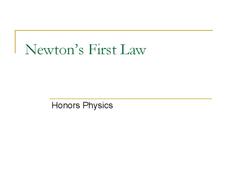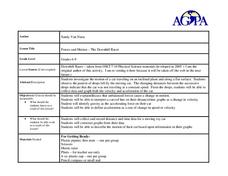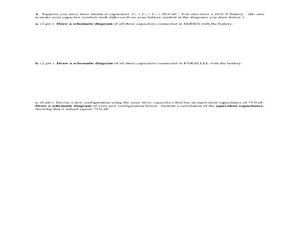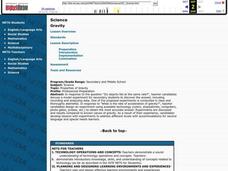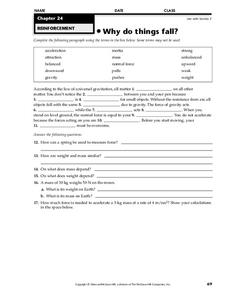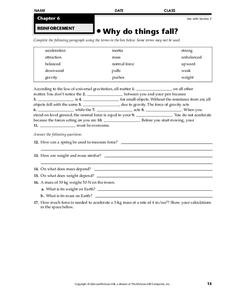LABScI
Kinematics: The Gravity Lab
Falling objects can be brutal if you don't protect your noodle! Scholars explore the motion of falling objects through measuring short intervals to determine if the distance traveled varies with time. Building off of this, scholars...
Bowels Physics
Newton's First Law
Force acts on objects in mysterious ways ... until now! A comprehensive presentation explains the balance of forces acting on objects. Learners draw free body diagrams to show these invisible forces and make force calculations.
Curated OER
Fractions, Decimals, and Gravity
Pupils discuss how weight is directly related to gravitational force on a planet. Students then choose Space Traveler as companion and compute how much their guide weighs on various planets, based on each planet's relative surface...
Curated OER
Center of Gravity Problem Set
Pupils read a NASA Web-based text, then demonstrate an understanding of the text by using it to complete an activity on the center of gravity of a commercial cargo airplane.
Curated OER
Newton: Force and Motion
In this forces worksheet, learners use the equations for acceleration and Newton's second law to learn about different motions and forces. This worksheet has 7 problems to solve.
Curated OER
Forces and Motion-The Downhill Racer
Learners calculate a toy car's velocity and acceleration. In this force and motion lesson, students build ramps and attach a dropper to a toy car, which is released down the ramp. Learners calculate and graph velocity and acceleration...
Curated OER
The Solar System and the Forces Behind It
Sixth graders discover why planets stay in orbit. In groups, they use everyday materials to examine the effect of gravity of objects and calculate how mass changes based on gravitational pull. To end the activity, they discuss how...
Curated OER
How Many Drops of Water Can Fit on a Penny?
Using a simple method, learners explore gravity, cohesion, and adhesion. They perform an experiment in which they determine how many drops of water can fit on a penny. Afterwards, they discuss their results.
Curated OER
Fall 2005 Midterm Exam #1
You've got the power! With this physics midterm, you have the power to assess learners' grasp of electricity concepts. The exam is neatly formatted and provides a variety of question types: true or false, multiple choice, and problem...
Curated OER
Midterm Exam #1, Electricity Concepts
The physics department at The University of Hawaii has designed midterm exams for their college physics courses. This version deals with electricity concepts. It requires learners to calculate conversions, capacitance, and potential...
Curated OER
Gravity
Students perform inquiry in response to the question "Do objects fall at the same rate?", teacher candidates discuss a model experiment for secondary students to discover the answer, including recording and analyzing data.
Curated OER
Describing Motion
In this motion worksheet, students will use Newton's third law of motion to compare the force of objects on Earth with objects on Jupiter. This worksheet has 5 short answer questions.
Curated OER
Weight A Minute
Students watch a video and engage in hands-on activities which introduce scientific information made real through re-cognition and understanding the phenomena of gravitational force and how it impacts life on our planet.
Curated OER
Gravitational Acceleration
Students investigate the interdependence of mass and gravitational acceleration using computer simulation. In this physics lesson, students derive the formula for acceleration due to gravity. They calculate air resistance on falling...
Curated OER
Why Do Things Fall?
In this universal gravitation worksheet, students fill in the blanks to complete sentences with 11 given terms about gravity, inertia, acceleration, mass and force. Students also answer 7 questions about mass, weight and force.
Curated OER
Physics and Me
Sixth graders compare and contrast mass and weight. For this physics lesson, 6th graders calculate speed given distance and time information. They construct a rocket and relate this to Newton's 3rd Law of motion.
Urbana School District
Gravitation
Introduction your class to famous astronomers with a presentation that also covers Newton's Laws of Gravitation, Kepler's Laws of Planetary Motion, both uniform and nonuniform gravitational fields, and how to calculate the gravitational...
Curated OER
Properties of Matter
This PowerPoint is a gem! Seventy-eight slides present an entire introduction to matter in bullet-point fashion. Viewers learn about everything from mass and inertia to phase changes and gas laws! The only glitch is that the links to...
Curated OER
Black Holes and Tidal Forces
In this black holes and tidal forces worksheet, learners solve 5 problems in which they find the tidal acceleration and answer questions about spaghettification.
Curated OER
Lesson-Mass and Weight
Student identify the three stationary positions, on the Earth, on the Moon, and in a house floating atop the cloud layers of Jupiter. They also identify the three orbiting positions, orbiting the Earth, orbiting the Moon, and orbiting...
Teach Engineering
Magical Motion
Make solutions to projectile motion problems magically appear using equations. Pupils watch a clip from a Harry Potter movie and find the length of time it takes for a remembrall to fall into Harry's hands. They use a projectile motion...
Curated OER
Walking on Water
Students use this problem to help them to relate to force vectors: Suspend a meterstick horizontally between two tables. Place a 1kg mass in the middle of the meterstick. Notice the bend of the meterstick. Explain why the meterstick...
Curated OER
Exploring Balancing Forces
Students develop critical thinking skills and explore the concept of force. In this balancing forces lesson students complete an activity and explain the conclusion.
Curated OER
Why Do Things Fall?
In this science worksheet, students complete a paragraph using 15 given terms. For example, "How can a spring be used to measure force?"



